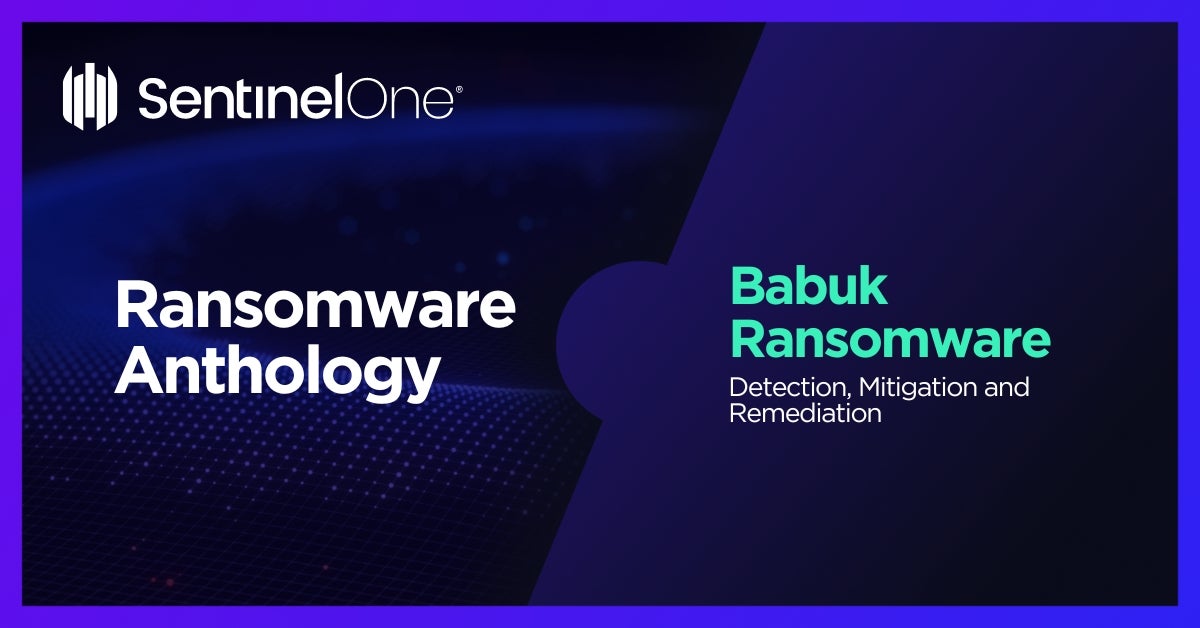Babuk Ransomware: In-Depth Analysis, Detection, Mitigation, and Removal
What Is Babuk Ransomware?
Babuk Ransomware is a highly advanced form of ransomware developed for multiple platforms, such as Windows and ARM for Linux. Babuk ransomware emerged in early 2020, and in March 2021 it opened to a more public RaaS model. It is sold and advertised on multiple underground marketplaces, and it has a dedicated blog for posting stolen victim data.
Babuk is associated with “Evil Corp” and is an evolution of malware families including WastedLocker, PhoenixLocker, Hades, and more. Source code and builders for Babuk have been made public, so anyone can build their own Babuk variant for Windows and Linux.

What Does Babuk Ransomware Target?
Babuk ransomware targets a wide range of industries, including healthcare, telecom, banking, finance, education, government, and critical infrastructure. It has been observed targeting a variety of organizations, including hospitals, universities, large enterprises, and small businesses.
How Does Babuk Ransomware Spread?
Babuk ransomware is typically spread through phishing emails with malicious attachments or links, malicious downloads, software vulnerabilities, and remote desktop protocol (RDP) connections. Attackers are also known to exploit vulnerable and exposed applications, such as CVE-2021-27065, and distribute the ransomware via Cobalt Strike or similar frameworks, like BRC4.
Babuk Ransomware Technical Details
Actors behind Babuk will vary greatly. Most observed attacks attempt to utilize basic OS features (e.g., RDP) to traverse victim environments. Many analyzed samples also accept specific commands and syntax to control movement (e.g., network vs. local-only encryption). The ransomware is typically deployed following the establishment of persistent infrastructure by way of Cobalt Strike. Babuk has continued to expand the features of their ransomware service, as well as carefully expanding their trusted affiliate network. Babuk payloads are known for working very quickly, achieving rapid encryption. Babuk uses AES-256 encryption to lock files on an infected computer. The ransomware will also attempt to stop or terminate processes and services which may inhibit the encryption process. After the encryption process is complete, the ransomware displays a ransom note on the victim’s desktop with instructions on how to pay the ransom.
Babuk ransomware is also capable of scanning for and exfiltrating data from victims’ systems, including sensitive information such as user credentials and credit card numbers. It is also capable of deleting system restore points and shadow copies, making it more difficult to recover files without paying the ransom.
In April of 2021, a now-removed post on Babuk’s blog indicated that they would be retiring their service and open-sourcing their platform.
How to Detect Babuk Ransomware
- The SentinelOne Singularity XDR Platform can identify and stop any malicious activities and items related to Babuk.
In case you do not have SentinelOne deployed, detecting this ransomware requires a combination of technical and operational measures, which are designed to identify and flag suspicious activity on the network. This allows the organization to take appropriate action, and to prevent or mitigate the impact of the ransomware attack.
- Use antimalware software, or other security tools, which are capable of detecting and blocking known ransomware variants. These tools may use signatures, heuristics, or machine learning algorithms, to identify and block suspicious files or activities.
- Monitor network traffic, and look for indicators of compromise, such as unusual network traffic patterns, or communication with known command-and-control servers.
- Conduct regular security audits and assessments, to identify vulnerabilities in the network and the system, and to ensure that all security controls are in place and functioning properly.
- Educate and train employees on cybersecurity best practices, including how to identify and report suspicious emails, or other threats.
- Implement a robust backup and recovery plan, to ensure that the organization has a copy of its data, and can restore it in case of an attack.
How to Mitigate Babuk Ransomware
- The SentinelOne Singularity XDR Platform can return systems to their original state using either the Repair or Rollback feature.
- Public Decryption Tool(s)
If you do not have SentinelOne deployed, there are several steps that organizations can take to mitigate the risk of Ryuk ransomware attacks.
Educate Employees
Employees should be educated on the risks of ransomware, and on how to identify and avoid phishing emails, malicious attachments, and other threats. They should be encouraged to report suspicious emails or attachments, and to avoid opening them, or clicking on links or buttons in them.
Implement Strong Passwords
Organizations should implement strong, unique passwords for all user accounts, and should regularly update and rotate these passwords. Passwords should be at least 8 characters long, and should include a combination of uppercase and lowercase letters, numbers, and special characters.
Enable Multi-factor Authentication
Organizations should enable multi-factor authentication (MFA) for all user accounts, to provide an additional layer of security. This can be done through the use of mobile apps, such as Google Authenticator or Microsoft Authenticator, or through the use of physical tokens or smart cards.
Update and Patch Systems
Organizations should regularly update and patch their systems, to fix any known vulnerabilities, and to prevent attackers from exploiting them. This includes updating the operating system, applications, and firmware on all devices, as well as disabling any unnecessary or unused services or protocols.
Implement Backup and Disaster Recovery
Organizations should implement regular backup and disaster recovery (BDR) processes, to ensure that they can recover from ransomware attacks, or other disasters. This includes creating regular backups of all data and systems, and storing these backups in a secure, offsite location.
The backups should be tested regularly, to ensure that they are working, and that they can be restored quickly and easily.